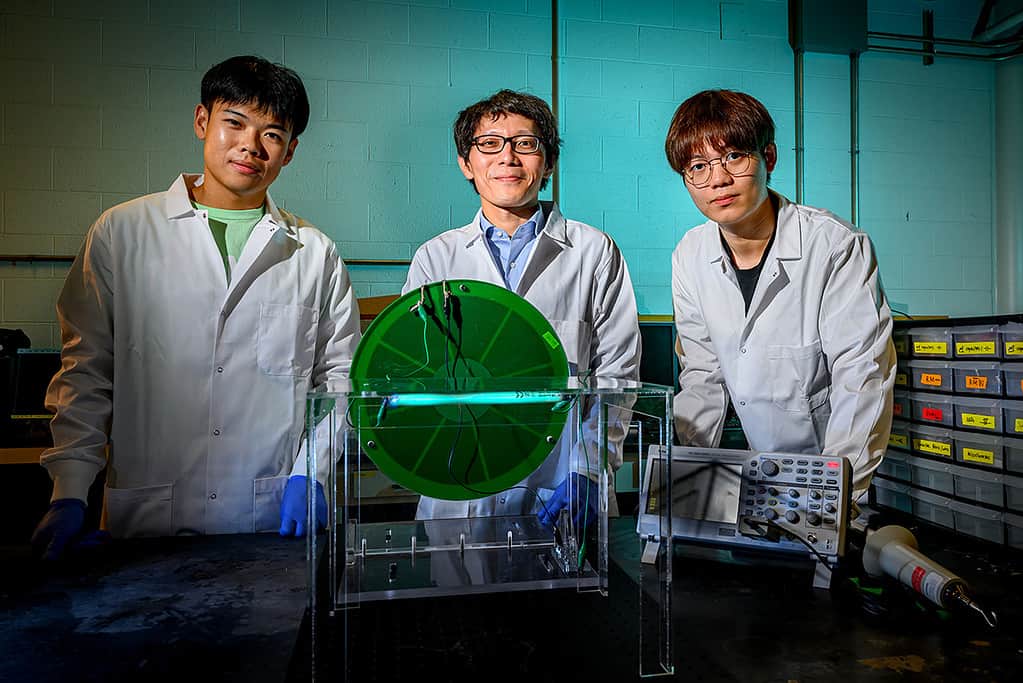
Every year, foodborne diseases kill 420,000 people globally. In the US, these diseases affect 48 million individuals annually, with 128,000 ending up in hospitals. Unfortunately, 3,000 of these patients never recover and eventually succumb to foodborne illness.
The financial burden of foodborne disease is also huge. It stands at a staggering $17.6 billion in the US and over $100 billion for many low-income countries.
But a new solution may be on the horizon.
A team of researchers from the University of Illinois Urbana-Champaign (UIUC) worked on the problem and developed the Tribo sanitizer, a portable device that can prevent two of the most dangerous foodborne bacteria from contaminating food items.
Tribo sanitizer is a self-powering ultraviolet-C lamp that works by damaging the DNA of microbes, eventually rendering them inactive. The researchers claim that their device can keep food items continuously decontaminated during transportation.
“If properly incorporated into existing facilities such as transportation or storage units, the Tribo-sanitizer could potentially provide continuous decontamination throughout the supply chain without the need for commercial power,” Yi-Cheng Wang, one of the study authors and a professor of food safety and engineering at UIUC, explained.
Testing the Tribo sanitizer
The two bacteria that Tribo-sanitizer promises to inactivate are Escherichia coli (strain O157:H7) and Listeria monocytogenes. The former releases toxins in the body, leading to diarrhea, fever, lower body pain, and even kidney failure.
Whereas the latter causes listeriosis, a disease associated with symptoms ranging from headache to muscle pain, and meningitis. Listeriosis is also considered responsible for the highest number of hospitalizations and deaths among all foodborne diseases.
The researchers tested the Tribo sanitizer on romaine lettuce, polyethylene terephthalate (also, called PET, a widely used food and beverage packing material), and fresh apple peels. Each of these food samples contained both E. coli and L. monocytogenes bacteria.
The Tribo sanitizer comprises a freestanding rotational triboelectric nanogenerator (TENG) that achieves rotation by motion caused by wind or humans. The mechanical energy harnessed from the rotational motion is then converted into electrical energy to light the UVC lamp.
As a result, the lamp generates ultraviolet rays of 254 nanometer wavelength. This is outside of the visible spectrum for humans. Typically, the human eye can detect wavelengths from 380 to 700 nanometers.
When researchers exposed the PET material to UV irradiation from the lamp, it caused the inactivation of 99.999% of E. coli bacteria. On apple peels and romaine lettuce, the UV rays resulted in the inactivation of 98 percent of L. monocytogenes and 99.8% of E. coli.
“Our results demonstrate Tribo-sanitizer’s excellent decontamination capability,” the researchers said.
Advantages and limitations of Tribo sanitizer
The study authors claim that their device can meet the FDA sanitization standards (food safety standards set by the US Food and Drug Administration), and it can work as an effective tool against foodborne illnesses, especially in low-income countries.
There are many other light-based decontamination systems that similar to the Tribo sanitizer. However, they need continuous electricity supply to operate. Additionally, they don’t produce power on their own and their need for an external power supply restricts their widespread use.
These advantages make this approach more scalable particularly in developing parts of the world — where something like this is needed most.
The approach could especially be useful in places with limited resources like disaster areas, conflict zones, and poor rural villages where either there is no infrastructure for power generation or electricity is not cheaply available. It’s not possible to implement such solutions.
Tribo sanitizer on the other hand utilizes TENG to produce its electricity sustainably at low or zero cost, “demonstrating its excellent potential for use in low-resource settings. With further improvements, it could help mitigate severe food-safety problems around the world, leading to a more secure and sustainable food system, ” the researchers note.
Moreover, a Tribo sanitizer can be made on a budget of $70, making it a super-affordable food decontamination solution.
Some limitations do exist
However, the device is not perfect. For instance, the UV light from the sanitizer may fail to reach areas with E. coli and L. monocytogenes on food items that have irregular surfaces.
Also, the device took 90 minutes during the experiment to decontaminate food items. While this duration may be acceptable for transportation and storage needs, a regular consumer might not be willing to wait 90 minutes at home to rid their food of bacteria.
The researchers will continue to improve the device and are hopeful about overcoming these limitations in the near future.
The study is published in the journal Nano Energy.


